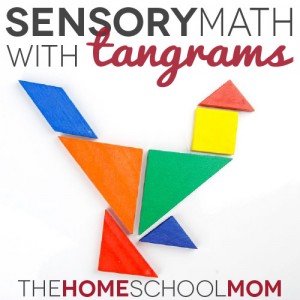 Tangrams, of Chinese origin, are simple seven-piece puzzles that build visual-spatial skills. Kids and adults alike enjoy manipulating the standardized pieces in the set, which includes a parallelogram, a square, and three sizes of right triangles. The pieces can be fit together to form a square, and in fact, when the puzzle pieces are made of wood, they are often stored in a square wooden frame.
Tangrams, of Chinese origin, are simple seven-piece puzzles that build visual-spatial skills. Kids and adults alike enjoy manipulating the standardized pieces in the set, which includes a parallelogram, a square, and three sizes of right triangles. The pieces can be fit together to form a square, and in fact, when the puzzle pieces are made of wood, they are often stored in a square wooden frame.
Sensory Play
The real fun and thinking occur in sensory play while moving the shapes around to form "pictures" or shapes. There is a real challenge in matching shapes that are already drawn out as puzzles to solve. Kids hold the pieces, called tans, in their hands and rotate them or slide them around on the table, trying out new placements. As they do this, they are growing their ability to "see" in their minds how the pieces might fit together.
Some kids find playing with tans to have a soothing quality, and if you have active children, you might find it is a good activity to do after boisterous play outside, transitioning to calm "close work" without moving to pencil and paper "schoolwork" too fast.
Side by Side Play
Tangrams are also a great "side by side" activity. Having a parent and several children working with individual tangram sets at the same table is fun, with everyone commenting on what they're making. If you use pieces that are large enough, or have a little one past the everything-goes-in-the-mouth stage, this is also an activity that toddlers and preschoolers can do to roughly emulate what older brothers and sisters are doing. Even though they won't be able to make the same shapes or follow the "rules" (pieces must lie flat, no overlapping, etc.), they'll feel included.
Rainbow Resources, a supplier familiar to many homeschoolers, has plastic tangram sets. You can also find more expensive wooden sets such as tangrams by MonkeyPod games. You can find handcrafted tangrams on Etsy, or your kids might have a grandparent who does woodworking who might be interested in creating a set. Older children might work with an adult to craft their own wooden set of tangrams.
Constructive Play
You can also make paper tangrams. These are frankly more difficult for preschool and some K-2 kids to manipulate and don't hold up as well, but many older children enjoy the process of making tangrams and then, of course, enjoy using the puzzle partly because they created them.
Instructions for making a tangram set from a single piece of paper are at Tom Scavo's math site on the Constructing Tangrams page.
The Tangram Channel is a rich website with tangram puzzles, video solutions, instructions for drawing your own tangram set, book recommendations, and tangram-related games. You even have the opportunity to "play against the clock," attempting to assemble your tans into the given patterns before time runs out -- but I admit this would certainly change the "calming effect" that I enjoyed at our house!
Virtual Play
I just did a homeschool evaluation for a seven year old girl whose mom had discovered a tangram app for her smart phone. Check out the various tangram apps for at iTunes and Google Play. My evaluation client had worked her way through all the tangram puzzles in the app they chose, and her mom felt it really helped her mentally "tune up" for math lessons. Of course, these don't have the sensory play advantage of being hands-on manipulatives, but there is the mental rotation of the shapes and the challenge of matching the puzzle outline.
For more about how tangrams may enhance cognitive development, read "How an Old Game Might Boost Spatial Skills and Boost Mathematics Performance" over at Parenting Science.
Playing with tangrams is something you can do in addition to or instead of using traditional homeschool curriculum, or you may find them incorporated into some math programs.
I loved keeping tangrams in easy reach of the slightly older kids (keep in mind that small tans are toddler choking hazards), and often found impromptu tangramming going on at the kitchen table.



 A popular speaker at homeschooling conferences, business groups, and parents’ groups, Jeanne Potts Faulconer homeschooled her three sons in North Carolina, Mississippi, and Virginia for twenty years. Holding her Master of Arts degree in Communication, Jeanne conducted portfolio evaluations for Virginia homeschoolers for evidence of progress for many years. Jeanne is a former college faculty member, former editor for several publications, news correspondent for WCVE, and former director of Brave Learner Home. She is the contributing editor for TheHomeSchoolMom newsletter and writes the popular Ask Jeanne column addressing homeschool parents' questions here at TheHomeSchoolMom.
A popular speaker at homeschooling conferences, business groups, and parents’ groups, Jeanne Potts Faulconer homeschooled her three sons in North Carolina, Mississippi, and Virginia for twenty years. Holding her Master of Arts degree in Communication, Jeanne conducted portfolio evaluations for Virginia homeschoolers for evidence of progress for many years. Jeanne is a former college faculty member, former editor for several publications, news correspondent for WCVE, and former director of Brave Learner Home. She is the contributing editor for TheHomeSchoolMom newsletter and writes the popular Ask Jeanne column addressing homeschool parents' questions here at TheHomeSchoolMom.
Such a creative article, Jean 🙂 I especially like the side by side play. I love activities that inspire conversation. We too used Tangrams in our homeschool. I think the best thing about Tangrams is their versatility--I once challenged my two children to tell a story with their Tangram Tiles. Such fun! I think the possibilities are endless here. Great stuff!